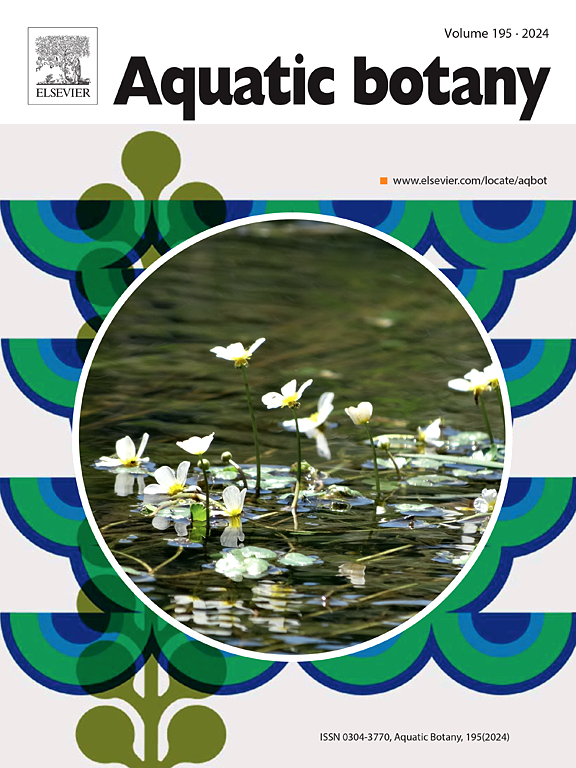Expansion of Halophila stipulacea in parallel with declines of native seagrasses in the eastern Mediterranean Sea
IF 2.6
4区 生物学
Q2 MARINE & FRESHWATER BIOLOGY
引用次数: 0
Abstract
Seagrasses native to the Mediterranean Sea are anticipated to be adversely affected by climate warming, while the invasive tropical seagrass species Halophila stipulacea is projected to proliferate and alter the region's underwater seascape. Despite the significant implications of this transition, it is surprisingly rare to include H. stipulacea in long-term monitoring programs across the Mediterranean. In July 2023, we conducted a follow-up study at a seagrass meadow in Limassol, Cyprus, which in 2017 was home to two native seagrass species, Cymodocea nodosa and Posidonia oceanica, alongside the invasive H. stipulacea. We assessed the seagrass cover of all present species and examined the characteristics of the H. stipulacea meadow, comparing our findings with data from 2017. Our results indicated a total loss of both native seagrass species, while H. stipulacea nearly doubled its coverage and exhibited substantial increases in shoot density, as well as above- and below-ground biomasses. Although our study is limited in scope, it supports earlier predictions regarding the anticipated transformations in the eastern Mediterranean's underwater landscape. This study highlights the urgent need to incorporate H. stipulacea into long-term seagrass monitoring efforts in the Mediterranean.
在地中海东部本地海草减少的同时,浅海海草也在扩大
原产于地中海的海草预计将受到气候变暖的不利影响,而入侵的热带海草物种Halophila stipulacea预计将大量繁殖并改变该地区的水下海景。尽管这一转变具有重大影响,但在整个地中海地区的长期监测计划中,却很少包括海草。2023 年 7 月,我们在塞浦路斯利马索尔(Limassol)的一片海草草甸开展了一项后续研究,该草甸在 2017 年曾是两种本地海草物种(Cymodocea nodosa 和 Posidonia oceanica)与入侵的 H. stipulacea 的家园。我们评估了所有现有物种的海草覆盖率,并检查了 H. stipulacea 草甸的特征,将我们的发现与 2017 年的数据进行了比较。我们的研究结果表明,两种本地海草物种都完全消失了,而H. stipulacea的覆盖率几乎翻了一番,并且表现出芽密度以及地上和地下生物量的大幅增加。尽管我们的研究范围有限,但它支持了早先对地中海东部水下景观预期变化的预测。这项研究强调了将 H. stipulacea 纳入地中海长期海草监测工作的迫切需要。
本文章由计算机程序翻译,如有差异,请以英文原文为准。
求助全文
约1分钟内获得全文
求助全文
来源期刊

Aquatic Botany
生物-海洋与淡水生物学
CiteScore
3.80
自引率
5.60%
发文量
70
审稿时长
6 months
期刊介绍:
Aquatic Botany offers a platform for papers relevant to a broad international readership on fundamental and applied aspects of marine and freshwater macroscopic plants in a context of ecology or environmental biology. This includes molecular, biochemical and physiological aspects of macroscopic aquatic plants as well as the classification, structure, function, dynamics and ecological interactions in plant-dominated aquatic communities and ecosystems. It is an outlet for papers dealing with research on the consequences of disturbance and stressors (e.g. environmental fluctuations and climate change, pollution, grazing and pathogens), use and management of aquatic plants (plant production and decomposition, commercial harvest, plant control) and the conservation of aquatic plant communities (breeding, transplantation and restoration). Specialized publications on certain rare taxa or papers on aquatic macroscopic plants from under-represented regions in the world can also find their place, subject to editor evaluation. Studies on fungi or microalgae will remain outside the scope of Aquatic Botany.
 求助内容:
求助内容: 应助结果提醒方式:
应助结果提醒方式:


